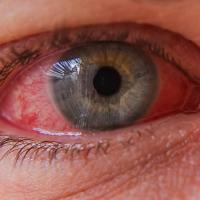Conjunctivitis, commonly known as pink eye, is the inflammation of the conjunctiva, a transparent membrane that lines the white part of the eyeball and the inner eyelids. pink eye symptoms often include redness, swelling, and discomfort in the eyes. It is a widespread condition and highly contagious, making early recognition and proper care essential to prevent its spread.
Causes of Conjunctivitis
Viral Conjunctivitis
Viral conjunctivitis is highly contagious and often occurs alongside respiratory infections like the common cold. It spreads through contact with infected eye secretions, contaminated surfaces, or close interaction with an infected person.
Bacterial Conjunctivitis
This type is caused by bacteria such as Staphylococcus aureus or Streptococcus pneumoniae. It leads to symptoms such as a thick discharge and significant redness. Bacterial conjunctivitis is also contagious, spreading quickly in shared environments.
Allergic Conjunctivitis
Unlike viral and bacterial types, allergic conjunctivitis is not contagious. It is triggered by allergens like pollen, dust mites, or pet dander. Common symptoms include itching, watery eyes, and redness.
Chemical Irritation
Chemical conjunctivitis occurs when the eyes are exposed to irritants such as chlorine, smoke, or harmful fumes. The severity depends on the chemical and the duration of exposure.
Symptoms of Conjunctivitis
The symptoms of conjunctivitis can vary depending on the cause but generally include:
• Redness: A noticeable pink or red hue in the whites of the eyes.
• Irritation: A gritty, itching, or burning sensation in the eyes.
• Discharge: Watery or thick mucus that may cause eyelids to stick together, especially in the morning.
• Tearing: Excessive production of tears.
• Swelling: Puffiness of the eyelids or conjunctiva.
• Light Sensitivity: Discomfort when exposed to bright light.
While most cases are mild, symptoms such as severe pain, blurred vision, or intense redness require immediate medical attention.
How Does Conjunctivitis Spread?
Conjunctivitis spreads easily, particularly viral and bacterial forms. Common ways include:
• Direct Contact: Touching infected eye secretions or coming into contact with someone who has the infection.
• Shared Items: Using towels, cosmetics, or handkerchiefs that have been in contact with an infected person.
• Surface Contamination: Touching contaminated surfaces and then rubbing the eyes.
Prevention Tips
Hygiene Practices
• Wash your hands regularly with soap and water.
• Avoid touching or rubbing your eyes unnecessarily.
Personal Item Management
• Do not share personal items like towels, washcloths, or cosmetics.
• Use disposable tissues for cleaning the eyes.
Contact Lens Care
• Ensure proper cleaning and storage of contact lenses.
• Avoid using contact lenses during an active eye infection.
Cleaning Discharge
Wipe any discharge using a clean, disposable tissue or cotton pad to avoid reinfection or spreading germs.
Treatment Options for Conjunctivitis
Viral Conjunctivitis
Viral conjunctivitis typically resolves on its own. Symptomatic relief can be achieved with artificial tears and cool compresses to reduce irritation.
Bacterial Conjunctivitis
For bacterial conjunctivitis, antibiotic eye drops or ointments prescribed by a healthcare professional are effective. Regular cleaning of discharge helps in speeding up recovery.
Allergic Conjunctivitis
Managing allergic conjunctivitis involves avoiding known allergens and using antihistamine eye drops. Keeping windows closed during pollen seasons can also help.
Chemical Conjunctivitis
If exposed to irritants, immediately flush the eyes with clean water and avoid further contact with the chemical. Seek medical attention if irritation persists.
Understanding Pink Eye: Causes, Symptoms, and Effective Management
0
162
SHARES2k
VIEWS
Entrepreneurs Break is mostly focus on Business, Entertainment, Lifestyle, Health, News, and many more articles.
Contact Here: [email protected]
Note: We are not related or affiliated with entrepreneur.com or any Entrepreneur media.
© 2025 - Entrepreneurs Break
